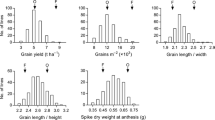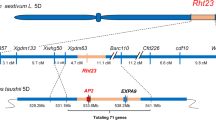Abstract
Q gene is the major domestication gene of wheat and many questions concerning Q gene genetics, including Q gene variability and its functional influence on phenotype, remain unanswered for the majority of wheat species. Here we crossed wheat species with dominant (Q) and recessive (q) alleles and confirmed that Q gene controls threshability, rachis fragility and spike shape traits. In the present study 18 new Q gene sequences were obtained and the Q gene sequences from 42 di- and polyploid wheat species with variable spike morphology were analyzed. We identified correlation between Q gene variability (coding mutation 329Val/Ile, promoter variability, microRNA172 binding site substitution) and threshability, rachis fragility and spike shape traits in polyploid wheat species. The analysis of 3D structures of q and Q proteins indicated that 329Val/Ile mutation does not affect overall protein structure and likely protein activity. We conclude that alterations in all three regions are essential for the formation of free-threshing non fragile normal phenotype in polyploid wheat.






Similar content being viewed by others
References
Altschul SF, Gish W, Miller W, Myers EW, Lipman DJ (1990) Basic local alignment search tool. J Mol Biol 215:403–410
Chen X (2004) A microRNA as a translational repressor of APETALA2 in Arabidopsis flower development. Science 303:2022–2025
Chuck G, Meeley R, Irish E, Sakai H, Hake S (2007) The maize tasselseed4 microRNA controls sex determination and meristem cell fate by targeting Tasselseed6/indeterminate spikelet1. Nat Genet 39:1517–1521
Dorofeev VF, Filatenko AA, Migushova EF, Udachin RA, Jakubtsiner MM (1979) Pshenitsa (Wheat). In: Dorofeev VF, Korovina ON (eds) Cultivated flora of the USSR, vol 1. Kolos, Leningrad, p 348
Dror O, Benyamini H, Nussinov R, Wolfson HJ (2003) Multiple structural alignment by secondary structures: algorithm and applications. Protein Sci 12:2492–2507
Dvorak J, Deal KR, Luo MC, You FM, von Borstel K, Dehghani H (2012) The origin of spelt and free-threshing hexaploid wheat. J Hered 103:426–441. doi:10.1093/jhered/esr152
Endo TR, Mukai Y (1988) Chromosome mapping of a speltoid suppression gene of Triticum aestivum L. based on partial deletions in the long arm of chromosome 5A. Japan J Genet 63:501–505
Faris JD, Gill BS (2002) Genomic targeting and high-resolution mapping of the domestication gene Q in wheat. Genome 45:706–718
Faris JD, Fellers JP, Brooks SA, Gill BS (2003) A bacterial artificial chromosome contig spanning the major domestication locus Q in wheat and identification of a candidate gene. Genetics 164:311–321
Faris JD, Simons KJ, Zhang Z, Gill BS (2006) The wheat super domestication gene Q. Frontiers of wheat bioscience: wheat information service 100:129–148
Feldman MF (2001) Origin of cultivated wheat. In: Bonjean AP, Angus WJ (eds) The world wheat book: a history of wheat breeding. Lavoisier Publishing, Paris, pp 1–56
Felsenstein J (1985) Confidence limits on phylogenies: an approach using the bootstrap. Evolution 39:783–791. doi:10.2307/2408678
Flaksberger KA (1935) Pshenitsi—rod Triticum L. pr. p. (Wheats—genus Triticum L. pr. p.). In: Wulff EV (ed) Cultivated flora of the USSR. Moscow, Leningrad, Gosselkhozgiz, pp 19–434
Golovnina KA, Kondratenko E, Blinov AG, Goncharov NP (2009) Phylogeny of the A genomes of wild and cultivated wheat species. Russ J Genet 45:1360–1367
Goncharov NP (2011) Genus Triticum L. taxonomy: the present and the future. Plant Syst Evol 295:1–11
Goncharov NP, Gaidalenok RF (2005) Localization of genes controlling spherical grain and compact ear in Triticum antiquorum Heer ex Udacz. Russ J Genet 41:1262–1267
Goncharov NP, Golovnina KA, Kilian B, Glushkov S, Blinov A, Shumny VK (2008) Evolutionary history of wheats—the main cereal of mankind. In: Dobretsov N et al (eds) Biosphere origin and evolution. Springer, New York, pp 407–419
Guindon S, Dufayard JF, Lefort V, Anisimova M, Hordijk W, Gascuel O (2010) New algorithms and methods to estimate maximum-likelihood phylogenies: assessing the performance of PhyML 3.0. Syst Biol 59:307–321. doi:10.1093/sysbio/syq010
Hammer K (1984) Das Domestikationssyndrom. Kulturpflanze 32:11–34
Hammer K, Filatenko AA, Pistrick K (2011) Taxonomic remarks on Triticum L. and × Triticocecale Wittm. Genet Resour Crop Evol 58:3–10
Higo K, Ugawa Y, Iwamoto M, Korenaga T (1999) Plant cis-acting regulatory DNA elements (PLACE) database: 1999. Nucleic Acids Res 27:297–300
Jantasuriyarat C, Vales MI, Watson CJ, Riera-Lizarazu O (2004) Identification and mapping of genetic loci affecting the free-threshing habit and spike compactness in wheat (Triticum aestivum L.). Theor Appl Genet 108:261–273
Kato K, Miura H, Sawada S (1999) QTL mapping of genes controlling ear emergence time and plant height on chromosome 5A of wheat. Theor Appl Genet 98:472–477
Kerber ER, Rowland GG (1974) Origin of the free threshing character in hexaploid wheat. Can J Genet Cytol 16:145–154. doi:10.1139/g74-014
Kimber G, Sears ER (1983) Assignment of genome symbols in Triticeae. In: Proceedings of the sixth International Wheat Genetics Symposium, Maruzen, Kyoto, Japan, pp 1195–1196
Kosuge KW, Watanabe N, Melnik VM, Laikova LI, Goncharov NP (2012) New sources of compact spike morphology determined by the genes on chromosome 5A in hexaploid wheat. Genet Resour Crop Evol 59:1115–1124
Koval SF (1997) The catolog of near-isogenic lines of Novosibirskaya-67 common wheat and principles of their use in experiments. Genetika 33:1168–1173
Leighty CE, Boshnakian S (1921) Genetic behaviour of the spelt form in crosses between Triticum spelta and Triticum aestivum. J Agri Res 7:335–364
Lescot M, Dehais P, Thijs G, Marchal K, Moreau Y, Van de Peer Y, Rouze P, Rombauts S (2002) PlantCARE, a database of plant cis-acting regulatory elements and a portal to tools for in silico analysis of promoter sequences. Nucleic Acids Res 30:325–327
Lu G, Moriyama EN (2004) Vector NTI, a balanced all-in-one sequence analysis suite. Brief Bioinform 5:378–388
MacKey J (1954) Neutron and X-ray experiments in wheat and a revision of the speltoid problem. Hereditas 40:65–180
MacKey J (1966) Species relationship in Triticum. Hereditas Suppl 2:237–275
Matsuoka Y (2011) Evolution of polyploid triticum wheats under cultivation: the role of domestication, natural hybridization and allopolyploid speciation in their diversification. Plant Cell Physiol 52:750–764. doi:10.1093/pcp/pcr018
Miller TE, Reader SM (1982) A major deletion of part of chromosome 5A of Triticum aestivum. Wheat Inf Serv 55:10–12
Muramatsu M (1963) Dosage effect of the spelta gene Q of hexaploid wheat. Genetics 48:469–482
Muramatsu M (1986) The vulgare super gene, Q: its universality in durum wheat and its phenotypic effects in tetraploid and hexaploid wheats. Can J Genet Cytol 28:30–41. doi:10.1139/g86-006
Nalam VJ, Vales MI, Watson CJ, Johnson EB, Riera-Lizarazu O (2007) Map-based analysis of genetic loci on chromosome 2D that affect glume tenacity and threshability, components of the free-threshing habit in common wheat (Triticum aestivum L.). Theor Appl Genet 116:135–145
Nilsson-Ehle H (1917) Untersuchungen über Speltoidmutationen beim Weizen. Bot Notiser, pp 305–329
Nilsson-Ehle H (1920) Multiple Allelomorphe und Komplexmutationen beim Weizen (Untersuchungen über Speltoidmutationen beim Weizen. II). Hereditas 1:277–311
Okonechnikov K, Golosova O, Fursov M, Yarlamov A, Vaskin Y, Efremov I, Grehov G, Kandrov D, Rasputin K, Syabro M et al (2012) UGENE: a unified bioinformatics toolkit. Bioinformatics 28:1166–1167. doi:10.1093/bioinformatics/bts091
Papoglou Ch, Coucolli H, Tsekos I (1981) Speltoid mutants of Triticum aestivum studied by cytological and electrophoretical methods. Berichte der Deutschen Botanischen Gesellschaft 93:689–700
Peng J, Sun D, Nevo E (2011) Wild emmer wheat, Triticum dicoccoides, occupies a pivotal position in wheat domestication process. Aust J Crop Sci 5:1127–1143
Pettersen EF, Goddard TD, Huang CC, Couch GS, Greenblatt DM, Meng EC, Ferrin TE (2004) UCSF Chimera–a visualization system for exploratory research and analysis. J Comput Chem 25:1605–1612
Roy A, Kucukural A, Zhang Y (2010) I-TASSER: a unified platform for automated protein structure and function prediction. Nat Protoc 5:725–738. doi:10.1038/nprot.2010.5
Salamini F, Ozkan H, Brandolini A, Schafer-Pregl R, Martin W (2002) Genetics and geography of wild cereal domestication in the near east. Nat Rev Genet 3:429–441
Sang T (2009) Genes and mutations underlying domestication transitions in grasses. Plant Physiol 149:63–70. doi:10.1104/pp.108.128827
Sears ER (1954) The aneuploids of common wheat. Mo Agr Exp Stat Res Bull 572:1–59
Simons KJ, Fellers JP, Trick HN, Zhang Z, Tai YS, Gill BS, Faris JD (2006) Molecular characterization of the major wheat domestication gene Q. Genetics 172:547–555
Sood S, Kuraparthy V, Bai G, Gill BS (2009) The major threshability genes soft glume (sog) and tenacious glume (Tg), of diploid and polyploid wheat, trace their origin to independent mutations at non-orthologous loci. Theor Appl Genet 119:341–351. doi:10.1007/s00122-009-1043-0
Swaminathan MS, Rao MVP (1961) Macro-mutations and sub-specific differentiation in Triticum. Wheat Inf Serv 13:9–11
Thompson JD, Higgins DG, Gibson TJ (1994) CLUSTAL W: improving the sensitivity of progressive multiple sequence alignment through sequence weighting, position-specific gap penalties and weight matrix choice. Nucleic Acids Res 22:4673–4680
Tsujimoto H (2001) Production of near-isogenic lines and marked monosomic lines in common wheat (Triticum aestivum) cv. Chinese Spring. J Hered 92:254–259
Winge Ö (1924) Zytologische Untersuchungen über speltoide und andere mutantenähnliche Aberranten beim Weizen. Hereditas 5:241–286
Zhang Z, Belcram H, Gornicki P, Charles M, Just J, Huneau C, Magdelenat G, Couloux A, Samain S, Gill BS et al (2011) Duplication and partitioning in evolution and function of homoeologous Q loci governing domestication characters in polyploid wheat. Proc Natl Acad Sci USA 108:18737–18742. doi:10.1073/pnas.1110552108
Acknowledgments
We thank Dr. Julie Hayes, Australian Centre for Plant Functional Genomics, the University of Adelaide, Australia, for helpful comments on our manuscript. Partial financial support of this investigation was provided by the Russian Foundation for Basic Research (Grant No. 12-04-01099-a) and Basis Project of RAS No. VI.53.1.1.
Author information
Authors and Affiliations
Corresponding author
Additional information
Irina Sormacheva and Kseniya Golovnina have contributed equally to this work.
Electronic supplementary material
Below is the link to the electronic supplementary material.
Rights and permissions
About this article
Cite this article
Sormacheva, I., Golovnina, K., Vavilova, V. et al. Q gene variability in wheat species with different spike morphology. Genet Resour Crop Evol 62, 837–852 (2015). https://doi.org/10.1007/s10722-014-0195-1
Received:
Accepted:
Published:
Issue Date:
DOI: https://doi.org/10.1007/s10722-014-0195-1




